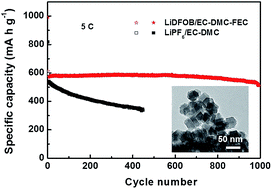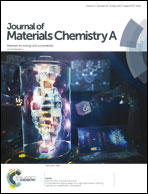A high performance lithium–selenium battery using a microporous carbon confined selenium cathode and a compatible electrolyte†
Abstract
Rechargeable lithium–selenium (Li–Se) batteries are promising electrochemical systems with higher energy density than traditional Li ion batteries. Nevertheless, the dissolution of high-order lithium selenides and the shuttle effect in electrolytes lead to low Se utilization, inferior capacity and poor cycling performance. This study proposes a combination of nanostructured Se cathode materials and compatible carbonate electrolytes for promoting the performance of Li–Se batteries. Se/MC composite nanoparticles (∼35 nm) with a moderate Se content (≈51.4 wt%) were prepared by embedding Se into a metal–organic framework derived microporous carbon. The resulting Se/MC cathode exhibits significantly high rate capability and cycling stability in LiDFOB/EC-DMC-FEC electrolyte. It delivers a capacity of 511 mA h gSe−1 after 1000 cycles at 5C, with an inappreciable capacity decay of 0.012% per cycle. Even at a very high rate of 20C, a large capacity of 569 mA h gSe−1 can be obtained, corresponding to a decrease of only 5.6% compared to that at 0.5C. The impressive high rate performance is attributed to the co-effect of selenium confined in ultra-small microporous carbon particles and excellent compatibility of the electrolyte with both the Li anode and selenium composite cathode.



 Please wait while we load your content...
Please wait while we load your content...